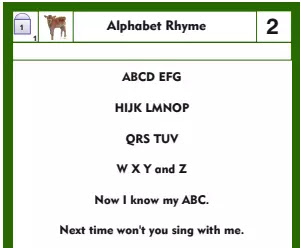Introduction
Unlike Kannada where students have to learn 50 letters, English has only half the number or 26 letters. Since it is a new language and children have to understand it well, this takes a whole year to teach the 26 alphabets. Like Kannada Nali Kali, we introduce the alphabet in a sequence that allows children to combine them to form simple words. These letters are not, therefore, not introduced in the alphabetic sequence.
{tocify} $title={Table of Contents}
 |
| Letter Chart |
The First Milestone; Alphabet Sequence Has Two Objectives:
1. To teach the alphabet sequence to the children.
2. To break the alphabet sequence into vowels and consonants.
Teaching the Alphabet Sequence:
The Alphabet Sequence is taught most easily through the ABCD song. Once that is taught children can play several games like making the alphabet train or adding the missing letters in the train.
This is a simple exercise and the only thing to remember is that it is a fun exercise and an easy one -children should feel that English is fun.
The Procedure of Teaching the Alphabet Sequence:
Materials Required:
- 4-5 sets of Letter Cards with capital and small letters on either side of the card.
- Letter Chart
Step 1:
- Take the students outside the class. Inform them that there is an alphabet rhyme that they can learn. This will help them to remember the order of the alphabet.
- Recite the rhyme and at the same time put a finger against each line as you say the rhyme.
- Repeat the rhyme until all students can say it.
Step 2:
Students to look at the chart and put the letters in a row.
- Begin with ABCD ask what the first four letters are. Make the students say ABCD and place the cards.
- Ask the students the next 3 letters. Make the students say EFG. Let the students place the cards EFG. They then read the entire sequence ABCD EFG
- Continue the process with HIJK. Let the students place the cards and read the sequence- ABCD EFG HIJK.
- Introduce LMNOP. Repeat the process as above. ABCD EFG HIJK LMNOP
- Introduce QRS TUV. Let the students say ABCD EFG HIJK LMNOP QRS TUV
- Introduce W, X. Y and Z. Let the students say ABCD EFG HIJK LMNOP QRS TUV W, X, Y and Z.
Step 3:
- Students work in groups of 3 or 4.
- Each group is given a set of 26 cards and students make the alphabet sequence.
- Next, give the group a complete set of 160 cards and then each student selects the alphabet and creates an alphabet train.
- If time permits, repeat the activity. Ask students to pick up the 26 letters first and then ask them to arrange them like a train.
Teaching the Vowels and Consonants:
Teaching the Vowels and consonants has three aims:
1. Helping children to understand that the 26 alphabets consist of 21 consonants and 5 vowels.
2. Helping students understand that words cannot be formed without vowels – all words have vowels.
3. Helping students understand that words are formed by joining vowels and consonants.
The first milestone is important not only because it teaches two important concepts – but it is also easy and fun and is designed to help children gain confidence.
Vowels' Activity:
Students are engaged in a series of reading and writing activities to understand vowels and consonants.
To begin with, they are asked to read a set of words and circle the letters - a, e, i, o and u. Then they are told that these are vowels. Following this, they are taught that vowels help in word-formation but words cannot be formed with vowels alone, They are also told that in Kannada, the vowels are known as "swaras".
Next, students are introduced to 21 consonants and told that words are formed using both vowels and consonants.
Consonants' Activity:
- Ask students to recall the number of letters in English. They will say 26. Ask them to say the vowels. They will say a, e, i, o, u.
- Now tell them that the remaining 21 letters are consonants similar to "vyanjanas" in Kannada.
- Explain to students that all words are a combination of vowels and consonants.
- Ask each student to say and write (in the workbook) any ten words they have learnt
- Let them circle the consonants in these words.
Fill in the Missing Vowels and Consonants:
Students are introduced to a lot of some new words represented by pictures in their workbook and asked to fill in the missing vowel or consonant to form words, looking at the pictures. The teacher can begin by asking children to identify each of the pictures with English words (almost all the words are in common usage or introduced in Level-1) and then leave them to complete the exercise and read aloud the words.
 |
| Fill in the blanks $ads={2} |
Summary:
Let us sum up what you learnt:
1. The first milestone has two objectives –
- To teach the alphabet sequence to the children
- To break the alphabet sequence into vowels and consonants
2. The alphabet sequence is taught most easily through the ABCD song
3. Teaching the Vowels and Consonants has the following aims:
- Helping children to understand that the 26 alphabets consist of 21 consonants and 5 vowels
- Helping students understand that words are formed by joining vowels and consonants.
-----
Download the Module: The Alphabet - Vowels and Consonants
Credits: Samagra Shikshana Karnataka and UNICEF{alertInfo}



